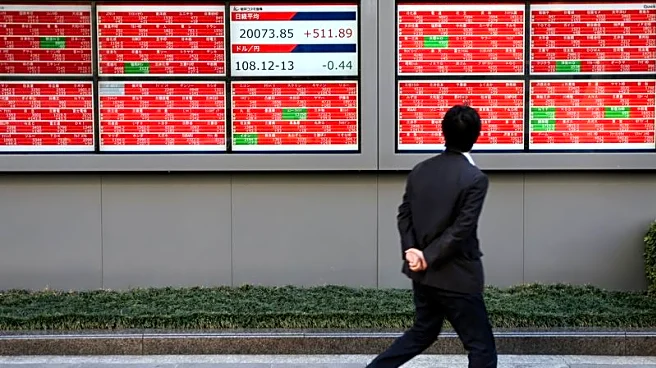What's Happening?
Major stock markets in the Gulf region experienced mixed results on Tuesday, influenced by weak oil prices and uncertainty surrounding U.S. Federal Reserve rate cuts. The Federal Reserve recently cut interest
rates for the second time this year, but Chair Jerome Powell indicated that further reductions are not guaranteed. This has led to a decrease in market expectations for a December rate cut, impacting Gulf markets where currencies are pegged to the dollar. Saudi Arabia's benchmark index TASI rose slightly, supported by gains in Saudi National Bank and Saudi Aramco. Aramco reported a third-quarter net profit of 101.02 billion riyals, a slight decrease from the previous year, but increased its 2030 sales gas production capacity target.
Why It's Important?
The mixed performance of Gulf markets underscores the region's sensitivity to global economic conditions, particularly U.S. monetary policy and oil price fluctuations. The Federal Reserve's decisions have a direct impact on Gulf economies due to currency pegs to the dollar, affecting trade and investment flows. The slight increase in Saudi Arabia's index reflects resilience in the face of economic challenges, driven by strategic moves by major companies like Aramco. The company's focus on expanding gas production capacity aligns with efforts to diversify energy sources and reduce reliance on oil, which is crucial for long-term economic stability.
What's Next?
As Gulf markets continue to navigate the impacts of U.S. monetary policy and oil price dynamics, investors may seek opportunities in sectors less affected by these factors, such as technology and renewable energy. The region's economic strategies may increasingly focus on diversification to mitigate risks associated with oil dependency. Additionally, further developments in U.S. interest rate policies could lead to adjustments in investment strategies and currency valuations in the Gulf.
Beyond the Headlines
The ongoing economic adjustments in the Gulf region highlight the need for strategic diversification and innovation to ensure sustainable growth. The focus on expanding gas production capacity by Aramco reflects a broader trend towards energy diversification, which may lead to environmental and regulatory considerations. The long-term implications of these shifts could redefine the region's economic landscape, fostering resilience and adaptability in the face of global economic changes.












